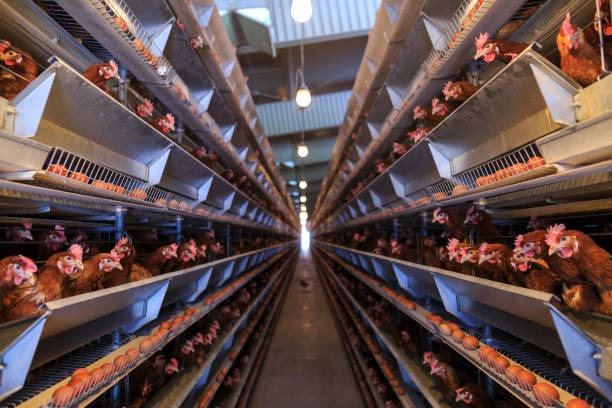When considering the construction of a giant chicken coop to house 10,000 chickens, it is essential to plan meticulously to ensure that the coop is not only large enough but also equipped with all necessary facilities to maintain the health and productivity of the flock. The following guide outlines key considerations and provides detailed insights into the requirements for such a large-scale chicken coop, also known as a chicken coop hutch or large outdoor chicken coop.
Livestock Density and Space Requirements
The first step in designing a giant chicken coop is to determine the appropriate space per chicken. Generally, the recommended space per chicken is as follows:
- Indoor space: Each chicken requires at least 1.5 to 2 square feet.
- Outdoor space: Each chicken should have about 8 to 10 square feet in the outdoor run.
Given that our objective is to house 10,000 chickens, the calculations are as follows:
- Indoor space: 10,000 chickens x 2 square feet = 20,000 square feet.
- Outdoor space: 10,000 chickens x 10 square feet = 100,000 square feet.
Therefore, the giant chicken coop needs to encompass at least 20,000 square feet indoors and have an outdoor run of 100,000 square feet for optimal chicken welfare.
Structural Design and Layout
Coop Structure
A large outdoor chicken coop must be robust, well-ventilated, and secure. Key structural elements to consider include:
- Frame: The coop should have a sturdy frame made from durable materials such as treated wood or metal to withstand weather conditions and the wear and tear of housing a large flock.
- Roofing: A well-insulated roof with proper drainage is crucial to protect the chickens from extreme weather conditions.
- Flooring: The coop floor should be easy to clean and maintain. Slatted floors can be beneficial as they allow droppings to fall through, keeping the living area cleaner.
- Ventilation: Proper ventilation is essential to prevent respiratory issues and maintain air quality. This can be achieved through windows, vents, and fans.
Interior Layout
The interior layout should facilitate efficient management and promote the well-being of the chickens. Important aspects include:
- Nesting Boxes: Provide one nesting box for every 4-5 hens. For 10,000 chickens, this equates to around 2,000 nesting boxes.
- Perches: Chickens need perches to roost. Allocate at least 8 inches of perch space per chicken.
- Feeders and Waterers: Ensure there are sufficient feeders and waterers to prevent overcrowding and ensure all chickens have access to food and water.
Outdoor Run
The outdoor run should be secure and spacious:
- Fencing: Use high-quality, predator-proof fencing to enclose the area.
- Shelter: Provide shaded areas and windbreaks to protect chickens from extreme weather.
- Ground Cover: Use grass or other soft ground covers to prevent foot problems and provide a natural environment for foraging.

Automated Systems
To manage a giant chicken coop effectively, integrating automated systems is highly beneficial. LIVI Poultry Equipment Factory offers various automated auxiliary equipment that can enhance the efficiency and productivity of the coop:
- Feeding Systems: Automated feeders ensure consistent and timely feeding, reducing labor costs and minimizing food wastage.
- Watering Systems: Automatic waterers provide a constant supply of fresh water, essential for the health of the chickens.
- Egg Collection Systems: Automated egg collection systems streamline the process of gathering eggs, reducing breakage and labor.
- Climate Control: Automated climate control systems help maintain optimal temperature and humidity levels, crucial for the welfare of the chickens.
Health and Biosecurity
Maintaining the health of a large flock requires stringent biosecurity measures:
- Quarantine Area: Designate a separate area for quarantining new or sick chickens to prevent the spread of diseases.
- Sanitation: Implement a regular cleaning and disinfection schedule for the coop and equipment.
- Vaccination and Health Checks: Ensure that chickens are vaccinated and regularly checked by a veterinarian.
Sustainable Practices
Incorporating sustainable practices in the management of a giant chicken coop can have long-term benefits:
- Waste Management: Implement systems for composting chicken manure, which can be used as fertilizer.
- Energy Efficiency: Use solar panels or other renewable energy sources to power automated systems and lighting.
- Water Conservation: Employ rainwater harvesting systems for watering the chickens.
Case Study: LIVI Poultry Equipment Factory
LIVI Poultry Equipment Factory, established in 1990, has over 30 years of experience in providing affordable and high-quality poultry equipment. Their extensive range of products includes:
- A-type Laying Hen Cages: Designed for optimal egg production, these cages provide a comfortable environment for laying hens.
- H-type Laying Hen Cages: These cages offer higher density housing, maximizing space utilization while ensuring the welfare of the hens.
- H-type Broiler Cages: Specifically designed for broilers, these cages promote healthy growth and efficient space use.
- Broiler Flat Farming Equipment: Ideal for large-scale broiler farming, this equipment supports a flat rearing system that promotes natural behavior.
- Automated Auxiliary Equipment: From feeding to egg collection, LIVI offers a range of automated systems that enhance the efficiency of poultry farming operations.
Conclusion
Designing a giant chicken coop for 10,000 chickens requires careful planning and consideration of various factors, including space requirements, structural design, automated systems, health and biosecurity, and sustainable practices. By leveraging the expertise and advanced poultry equipment offered by LIVI Poultry Equipment Factory, farmers can create a highly efficient and productive environment for their chickens. This not only ensures the welfare of the flock but also contributes to the overall success and sustainability of the poultry farming operation.